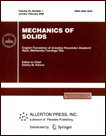 | | Mechanics of Solids
A Journal of Russian Academy of Sciences | | Founded
in January 1966
Issued 6 times a year
Print ISSN 0025-6544
Online ISSN 1934-7936 |
Archive of Issues
| Total articles in the database: | | 13362 |
| In Russian (Èçâ. ÐÀÍ. ÌÒÒ): | | 8178
|
| In English (Mech. Solids): | | 5184 |
|
| << Previous article | Volume 59, Issue 5 / 2024 | Next article >> |
| I.S. Nikitin, N.G. Burago, A.D. Nikitin, and B.A. Stratula, "Fatigue Strength under High Frequency Loading of Materials Produced by Selective Laser Melting," Mech. Solids. 59 (5), 2789-2805 (2024) |
| Year |
2024 |
Volume |
59 |
Number |
5 |
Pages |
2789-2805 |
| DOI |
10.1134/S0025654424604762 |
| Title |
Fatigue Strength under High Frequency Loading of Materials Produced by Selective Laser Melting |
| Author(s) |
I.S. Nikitin (Institute for Computer Aided Design of the RAS, Moscow, 123056 Russia, i_nikitin@list.ru)
N.G. Burago (Institute for Computer Aided Design of the RAS, Moscow, 123056 Russia; Ishlinsky Institute for Problems in Mechanics RAS, Moscow, 119526 Russia)
A.D. Nikitin (Institute for Computer Aided Design of the RAS, Moscow, 123056 Russia)
B.A. Stratula (Institute for Computer Aided Design of the RAS, Moscow, 123056 Russia) |
| Abstract |
The mathematical modeling of the selective laser melting process of metallic alloy powders
for the construction of metal products has been carried out within the framework of the enthalpy formulation of the three-dimensional non-stationary nonlinear heat conductivity problem for a multiphase system. The parameters of the geometry of a single track, as well as single-layer and multilayer
systems of overlapping tracks, depending on the power and speed of the laser beam have been determined that makes it possible to estimate the structure and types of defects occuring during layer-by-layer printing of specimens. To study the effect of single and multiple defects on the fatigue behavior
of printed specimens under high-frequency loading, the previously proposed multi-mode model of
cyclic damage has been used. It is shown that the internal heterogeneity of the microstructure of materials printed by selective laser melting can lead to earlier subsurface nucleation of fatigue cracks and
significantly reduce the fatigue strength and durability. This effect is more pronounced for systems of multiple defects. The proposed models and calculation algorithms allow us to calculate the fatigue
strength and durability of specimens for various systems of microstructure defects corresponding to the specified characteristics of a moving laser beam, as well as to determine the range of parameters of
the selective laser melting process, in which the best fatigue strength indicators are achieved under high-frequency loading. |
| Keywords |
additive technologies, selective laser melting, defect structure, high-frequency loading, cyclic damage model |
| Received |
23 July 2024 | Revised |
24 July 2024 | Accepted |
24 July 2024 |
| Link to Fulltext |
|
| << Previous article | Volume 59, Issue 5 / 2024 | Next article >> |
|
 If you find a misprint on a webpage, please help us correct it promptly - just highlight and press Ctrl+Enter If you find a misprint on a webpage, please help us correct it promptly - just highlight and press Ctrl+Enter
|
|

 Russian
Russian  English
English